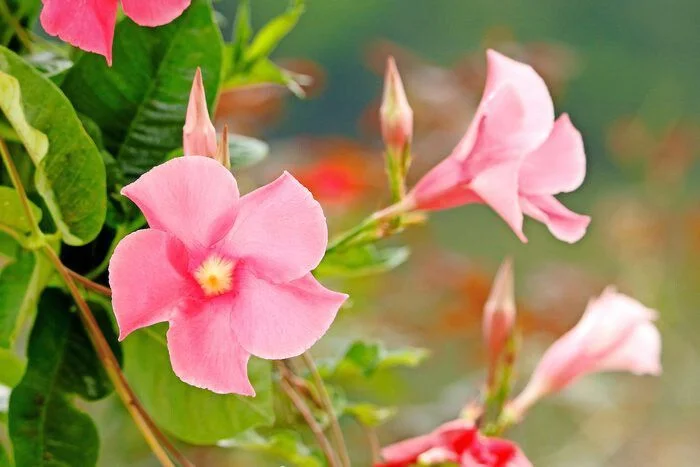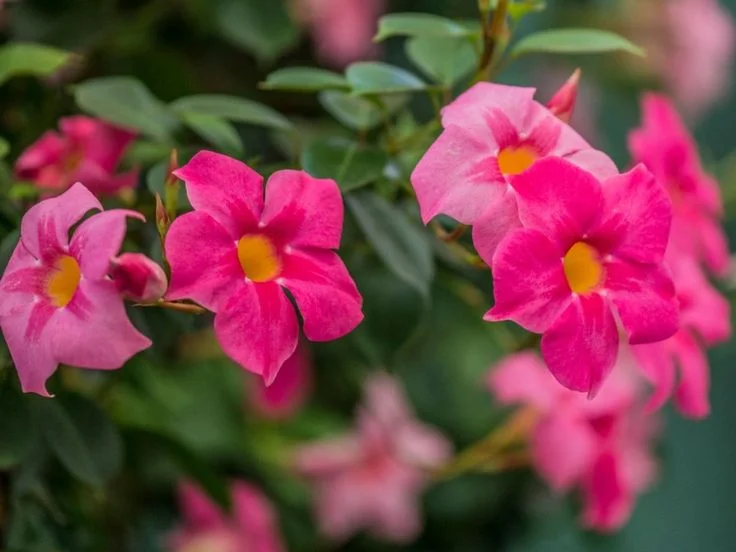Mandevilla plants are prized for their bold, trumpet-shaped flowers and vigorous vines that add tropical charm to patios, balconies, and gardens. To thrive, they require consistent feeding throughout the growing season. With the right fertilizer for mandevilla plant, you’ll enjoy continuous blooms, strong vines, and improved resistance against pests and diseases.
Why Fertilizer Matters for Mandevilla Plants
Although mandevilla plants grow quickly, they are heavy feeders. Without consistent nutrients, they may show yellow leaves, produce fewer flowers, or develop weak stems. Fertiliser provides the three essential macronutrients needed for balance:
-
Nitrogen (N): Supports leafy, green growth.
-
Phosphorus (P): Boosts flower production and strengthens roots.
-
Potassium (K): Improves overall plant health and enhances disease resistance.
Because mandevilla blooms continuously during warm months, it requires a nutrient-rich and bloom-focused fertilizer plan.
Best Fertilizer for Mandevilla Plant

Choosing the right fertilizer depends on the plant’s growth stage. Transitioning between formulas at the right time ensures maximum blooms and healthy foliage.
1. Balanced Fertilizer (10-10-10 or 20-20-20)
At the beginning of spring, use a balanced fertilizer to encourage strong root systems and leafy growth.
Pro Tip: Apply a diluted liquid solution every two weeks for best absorption.
2. Bloom-Boosting Fertilizer (10-20-10 or 15-30-15)
When buds begin forming, switch to a phosphorus-rich formula. This adjustment encourages more flowers and extends blooming cycles.
3. Slow-Release Granules
If you prefer low-maintenance care, slow-release fertilizers are ideal. They provide nutrients steadily for up to 3–4 months, which is especially useful for container-grown mandevilla.
4. Organic Fertilizers
Natural options such as fish emulsion, compost tea, and bone meal enrich soil while feeding the plant.
Professional Tip: Alternate between organic and synthetic fertilizers to balance fast results with long-term soil health.
How to Apply Fertilizer for Mandevilla Plant
Applying fertilizer correctly is just as important as choosing the right type. The right timing, dosage, and placement help the plant absorb nutrients safely and effectively.
Step 1: Timing Matters
In spring, begin with a balanced fertilizer to encourage leafy growth and strong roots. As the season progresses into summer, switch to a bloom-boosting formula that promotes continuous flowering. By fall, reduce the feeding schedule, since growth naturally slows before dormancy.
Step 2: Frequency of Application
Liquid fertilizers work best when applied every two weeks during the active growing season. For gardeners who prefer convenience, slow-release granules can be added every 2–3 months, depending on the product instructions. This approach ensures a steady flow of nutrients.
Step 3: Placement and Watering
Spread fertilizer evenly around the root zone, keeping it away from stems and leaves to prevent burns. Once applied, water the plant thoroughly so the nutrients soak into the soil and reach the roots effectively.
Pro Tip: Alternate between liquid feedings and slow-release options to maintain consistent nourishment without overwhelming the plant.
Fertilizer for Mandevilla Plant in Pots vs. Ground

It adapts to both containers and garden beds, but fertilizer needs differ slightly.
In Containers
Since nutrients leach out faster due to frequent watering, potted mandevilla plants need more regular feeding. Use liquid fertilizer every two weeks or controlled-release pellets.
In Garden Beds
Soil retains nutrients better outdoors. Still, enriching the soil with compost at planting and following up with bloom fertilizers ensures steady performance, just as recommended for Ixora plants to maintain vibrant blooms and healthy growth.
Common Fertilizer Mistakes to Avoid
Even though mandevilla needs feeding, improper fertilization can harm rather than help.
-
Over-Fertilizing
Too much nitrogen produces leafy growth but reduces flower production. -
Ignoring Soil Drainage
If soil drains poorly, roots cannot absorb nutrients properly. Always use a light, well-draining soil mix. -
Fertilizing During Dormancy
Mandevilla slows down in cooler months. Feeding at this stage wastes nutrients and may stress the plant.
Transition Tip: For instance, watch for warning signs such as yellow leaves, stunted growth, or weak stems—these often signal incorrect feeding.
Additional Care Tips Alongside Fertilization

Fertilizer is just one part of mandevilla care. Combining proper nutrition with other practices creates the best results.
-
Sunlight: Provide 6–8 hours of direct sunlight daily.
-
Watering: Keep the soil consistently moist, but avoid waterlogging.
-
Pruning: Trim vines in late winter or early spring to encourage new shoots.
-
Support: Train the plant on a trellis or stake to promote climbing growth.
FAQs
What is the best fertilizer ratio for mandevilla?
A 10-20-10 or 15-30-15 formula works best during flowering, while a 10-10-10 blend supports early growth.
Can I use tomato fertilizer for mandevilla?
Yes. Tomato fertilizer is rich in phosphorus and potassium, which benefit mandevilla’s blooms.
How often should I fertilize mandevilla in pots?
Fertilize every two weeks with liquid feed or every 2–3 months with slow-release pellets.
Should I fertilize mandevilla in winter?
No. During dormancy, the plant does not require fertilizer. Resume feeding in spring.
Is organic fertilizer enough for mandevilla?
Organic options are beneficial but act more slowly. Combining them with synthetic fertilizers often produces the best balance.
Fertilizer for Mandevilla Plant: Conclusion
Providing the right fertilizer for mandevilla plant transforms it into a show-stopping garden centerpiece. For example, by starting with a balanced formula in spring, switching to bloom boosters in summer, and reducing feeding in fall, you’ll maximize both growth and flower production.
Moreover, consistency is essential, but so is balance. In addition, pair regular feeding with adequate sunlight, watering, and pruning. Meanwhile, pay attention to soil health and drainage to avoid root stress. For guidance on fertilizing other ornamental plants, such as eucalyptus, check out this helpful fertilization guide for eucalyptus plants. However, avoid overfertilizing, as this can harm the plant. Instead, opt for moderate applications that support steady growth.
Consequently, when done correctly, your mandevilla will reward you with lush green foliage and a continuous cascade of trumpet-shaped blooms. As a result, your garden space will look more vibrant and inviting. Ultimately, the right care ensures your mandevilla thrives year after year. Finally, remember that steady attention is the key to long-term tropical beauty.


















